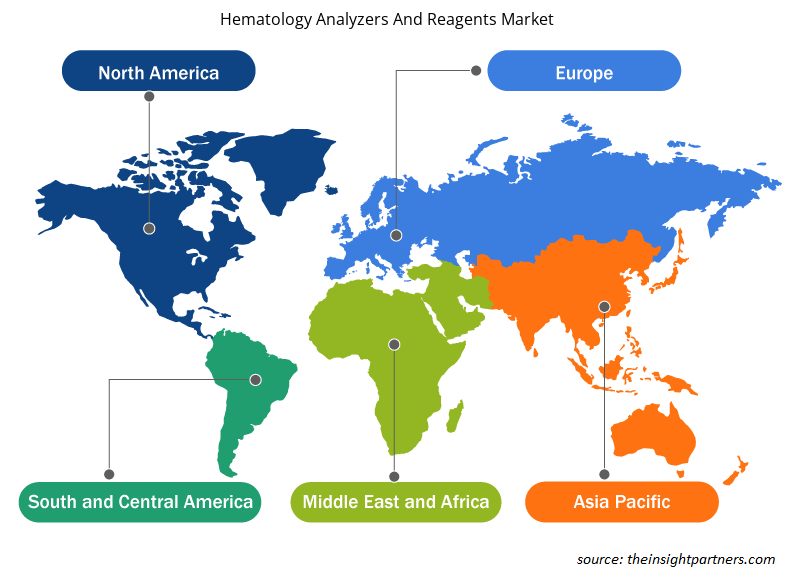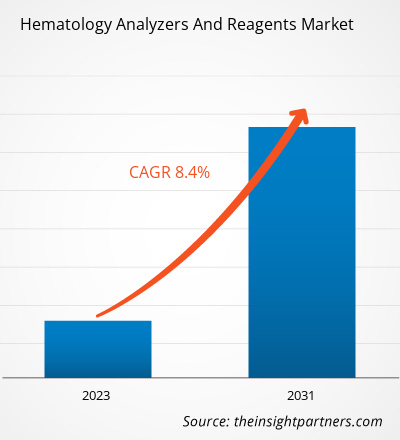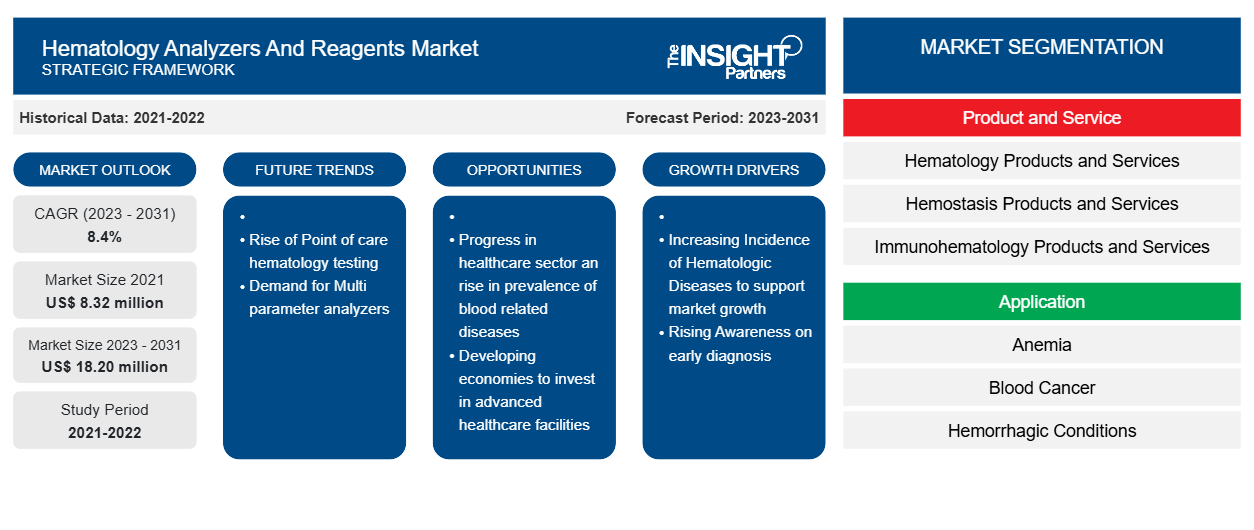La taille du marché des analyseurs et réactifs d'hématologie a été estimée à 8,32 millions USD en 2021 et à XX millions USD en 2023 et devrait atteindre 18,20 millions USD d'ici 2031 ; elle devrait enregistrer un TCAC de 8,4 % jusqu'en 2031. L'adoption croissante d'appareils intelligents au point de service devrait rester l'une des principales tendances du marché des analyseurs et réactifs d'hématologie.
Analyse du marché des ANALYSEURS ET RÉACTIFS D'HÉMATOLOGIE
Les acteurs opérant sur le marché des analyseurs et réactifs d'hématologie sont très compétitifs et ont introduit de nouveaux produits et réactifs. Par exemple, en janvier 2024, HORIBA Medical a lancé la dernière plateforme d'hématologie automatisée à haut débit HELO 2.0. La plateforme est approuvée par le règlement européen sur les dispositifs de diagnostic in vitro (IVDR) CE et attend actuellement l'approbation de la Food and Drug Administration (FDA) américaine. Le HELO 2.0 est la nouvelle génération de gamme d'hématologie haut de gamme et a été développé en consultation avec les clients pour répondre à tous les besoins d'hématologie entièrement automatisée à haut débit. Le HELO 2.0 offre une solution d'hématologie modulaire hautement flexible et efficace, qui peut être entièrement évolutive et configurée pour répondre aux différents besoins des laboratoires de moyenne à grande échelle. De même, en mai 2023, Siemens Healthineers a lancé deux solutions pour les tests d'hématologie à haut volume : l'analyseur Atellica HEMA 570 et l'analyseur Atellica HEMA 580. La capacité du laboratoire à examiner et à publier rapidement les résultats des tests des patients est entravée par l'utilisation généralisée des tests NFS et par la pénurie croissante de personnel. Les analyseurs Atellica HEMA 570 et Atellica HEMA 580 offrent une automatisation et une intelligence intégrées pour améliorer l'efficacité du flux de travail et produire des résultats plus rapides pour les patients. Le lancement de ces nouveaux produits alimente la croissance du marché des analyseurs et réactifs hématologiques.
Aperçu du marché des ANALYSEURS ET RÉACTIFS D'HÉMATOLOGIE
La croissance du marché des analyseurs et réactifs hématologiques est attribuée au nombre croissant de maladies hématologiques et aux avancées technologiques dans les analyseurs hématologiques. Cependant, les prix élevés des systèmes haut de gamme freinent probablement la croissance du marché.
Le marché mondial des analyseurs et réactifs d'hématologie est segmenté par région en Amérique du Nord, Europe, Asie-Pacifique, Moyen-Orient et Afrique, et Amérique du Sud et centrale. La région Amérique du Nord est le plus grand actionnaire et l'Asie-Pacifique est le marché qui connaît la croissance la plus rapide pour les analyseurs et réactifs d'hématologie. On estime que la croissance du marché des analyseurs et réactifs d'hématologie a la plus grande part aux États-Unis. La croissance du marché aux États-Unis devrait augmenter en raison d'un nombre croissant de procédures d'analyse sanguine, d'une forte prévalence des maladies hématologiques, d'un nombre croissant de centres de diagnostic et d'analyse sanguine et d'un accès à des infrastructures bien développées et autres.
Personnalisez ce rapport en fonction de vos besoins
Vous bénéficierez d'une personnalisation gratuite de n'importe quel rapport, y compris de certaines parties de ce rapport, d'une analyse au niveau des pays, d'un pack de données Excel, ainsi que d'offres et de remises exceptionnelles pour les start-ups et les universités.
-
Obtenez les principales tendances clés du marché de ce rapport.Cet échantillon GRATUIT comprendra une analyse de données, allant des tendances du marché aux estimations et prévisions.
Moteurs et opportunités du marché des ANALYSEURS ET RÉACTIFS D'HÉMATOLOGIE
L'incidence croissante des maladies hématologiques favorise le marché
Selon les Centres pour le contrôle et la prévention des maladies (CDC), environ 12 hommes sur 100 000 et 400 garçons naissent chaque année aux États-Unis avec l'hémophilie A. De plus, la Leukemia & Lymphoma Society (LLS) rapporte qu'aux États-Unis, une personne reçoit un diagnostic de lymphome, de leucémie ou de myélome toutes les 3 minutes. En 2023, on estime que 184 720 personnes aux États-Unis devraient recevoir un diagnostic de leucémie, de lymphome ou de myélome. En outre, les nouveaux cas de lymphome, de leucémie et de myélome devraient représenter 9,4 % des 1 958 310 nouveaux cas de cancer qui seront diagnostiqués aux États-Unis en 2023. La prévalence croissante des maladies hématologiques augmente la demande de transfusion sanguine ainsi que de numération des cellules sanguines pour surveiller la normalité, ce qui accroît encore la demande d'analyseurs et de réactifs hématologiques. L’incidence croissante des maladies liées au sang accroît la croissance du marché des analyseurs et réactifs d’hématologie.
Progrès dans le secteur de la santé et augmentation de la prévalence des maladies liées au sang dans les économies émergentes – Une opportunité sur le marché des analyseurs et réactifs hématologiques
L'incidence des maladies hématologiques augmente considérablement dans les pays en développement en raison du changement de mode de vie des populations. De plus, la prévalence croissante d'autres problèmes de santé en raison de la diminution des activités physiques et de l'augmentation des niveaux de stress contribue également à l'augmentation des cas de troubles hématologiques dans ces pays. Les pays en développement s'efforcent d'apporter des avancées significatives dans leurs installations et services de santé. Par exemple, la Hemophilia Federation India (HFI) est une organisation à but non lucratif qui a travaillé en étroite collaboration avec la World Federation of Hemophilia (WFH) pour accroître la sensibilisation à l'hémophilie et aux traitements abordables disponibles pour cette maladie, ainsi que pour améliorer le diagnostic de la maladie. De plus, l'équipe professionnelle de RED LAPI s'efforce de contribuer et d'améliorer le diagnostic et le traitement de l'hémophilie en Amérique latine. De tels développements sur le marché des analyseurs et réactifs hématologiques dans les pays en développement d'Asie-Pacifique, du Moyen-Orient et d'Afrique, et d'Amérique latine, offrent des opportunités de croissance future pour les acteurs du marché.
Analyse de segmentation du rapport de marché des ANALYSEURS ET RÉACTIFS D'HÉMATOLOGIE
Les segments clés qui ont contribué à la dérivation des analyseurs et réactifs d’hématologie L’analyse du marché est le produit et le service, la cause, l’application et l’utilisateur final.
- Sur la base des produits et services, le marché des analyseurs et réactifs d'hématologie est segmenté en produits et services d'hématologie, produits et services d'hémostase et produits et services d'immunohématologie. Les produits et services d'hématologie sont subdivisés en instruments, réactifs et consommables et services. De même, le segment des produits et services d'hémostase est subdivisé en instruments, réactifs et consommables et services. Le segment des produits et services d'immunohématologie du marché des analyseurs et réactifs d'hématologie est également subdivisé en instruments, réactifs et consommables et services. Le segment des produits et services d'hématologie détenait une part de marché plus importante en 2023.
- En fonction des applications, le marché est segmenté en anémie, cancer du sang, affections hémorragiques, affections liées aux infections, affections liées au système immunitaire et autres applications. Le segment de l'anémie détenait la plus grande part du marché en 2023.
- En termes d'utilisateur final, le marché est segmenté en laboratoires hospitaliers, prestataires de services commerciaux, laboratoires de référence gouvernementaux et instituts de recherche et universitaires. Le segment des laboratoires hospitaliers a dominé le marché en 2023.
Analyse des parts de marché des analyseurs et réactifs d'hématologie par géographie
La portée géographique du rapport sur le marché des analyseurs et réactifs d’hématologie est principalement divisée en cinq régions : Amérique du Nord, Asie-Pacifique, Europe, Moyen-Orient et Afrique, et Amérique du Sud/Amérique du Sud et centrale.
En Amérique du Nord, les États-Unis constituent le plus grand marché pour la fabrication d'analyseurs et de réactifs d'hématologie. La croissance du marché américain est principalement tirée par des scénarios de recherche favorables, une demande croissante de sang et de composants sanguins et une adoption élevée d'instruments d'hématologie automatisés.
La prévalence des troubles hématologiques tels que la leucémie, l'hémophilie et l'anémie augmente aux États-Unis. Les estimations de l'American Cancer Society concernant la leucémie aux États-Unis pour 2024 sont les suivantes :
- Environ 62 770 nouveaux cas de leucémie (tous types confondus) et 23 670 décès dus à la leucémie (tous types confondus)
- Environ 20 800 nouveaux cas de leucémie myéloïde aiguë (LMA). La plupart concerneront des adultes.
- Environ 11 220 décès dus à la LAM. Presque tous concerneront des adultes.
La sensibilisation croissante des patients au diagnostic précoce devrait être l'un des principaux moteurs du marché des analyseurs et réactifs hématologiques. L'Asie-Pacifique devrait connaître le TCAC le plus élevé dans les années à venir.
Analyseurs et réactifs d'hématologie : aperçu régional du marché
Les tendances et facteurs régionaux influençant le marché des analyseurs et réactifs d’hématologie tout au long de la période de prévision ont été expliqués en détail par les analystes d’Insight Partners. Cette section traite également des segments et de la géographie du marché des analyseurs et réactifs d’hématologie en Amérique du Nord, en Europe, en Asie-Pacifique, au Moyen-Orient et en Afrique, ainsi qu’en Amérique du Sud et en Amérique centrale.

- Obtenez les données régionales spécifiques au marché des analyseurs et réactifs d'hématologie
Portée du rapport sur le marché des analyseurs et réactifs d'hématologie
| Attribut de rapport | Détails |
|---|---|
| Taille du marché en 2021 | 8,32 millions de dollars américains |
| Taille du marché d'ici 2031 | 18,20 millions USD |
| Taux de croissance annuel composé mondial (2023-2031) | 8,4% |
| Données historiques | 2021-2022 |
| Période de prévision | 2023-2031 |
| Segments couverts |
Par produit et service
|
| Régions et pays couverts |
Amérique du Nord
|
| Leaders du marché et profils d'entreprises clés |
|
Densité des acteurs du marché des analyseurs et réactifs d'hématologie : comprendre son impact sur la dynamique commerciale
Le marché des analyseurs et réactifs d'hématologie connaît une croissance rapide, tirée par la demande croissante des utilisateurs finaux en raison de facteurs tels que l'évolution des préférences des consommateurs, les avancées technologiques et une plus grande sensibilisation aux avantages du produit. À mesure que la demande augmente, les entreprises élargissent leurs offres, innovent pour répondre aux besoins des consommateurs et capitalisent sur les tendances émergentes, ce qui alimente davantage la croissance du marché.
La densité des acteurs du marché fait référence à la répartition des entreprises ou des sociétés opérant sur un marché ou un secteur particulier. Elle indique le nombre de concurrents (acteurs du marché) présents sur un marché donné par rapport à sa taille ou à sa valeur marchande totale.
Les principales entreprises opérant sur le marché des analyseurs et réactifs d'hématologie sont :
- Solutions de diagnostic clinique, Inc.
- Shenzhen Mindray Bio-Medical Electronics Co., Ltd.
- Danaher
- LABORATOIRES BIO-RAD INC.
- Abbott
- Diatron
Avis de non-responsabilité : les sociétés répertoriées ci-dessus ne sont pas classées dans un ordre particulier.

- Obtenez un aperçu des principaux acteurs du marché des analyseurs et réactifs d'hématologie
Actualités et développements récents du marché des analyseurs et réactifs d'hématologie
Le marché des analyseurs et réactifs d'hématologie est évalué en collectant des données qualitatives et quantitatives après des recherches primaires et secondaires, qui comprennent des publications d'entreprise importantes, des données d'association et des bases de données. Voici une liste des développements sur le marché des analyseurs et réactifs d'hématologie et des stratégies :
- HORIBA Medical a lancé de nouveaux produits dans sa gamme de produits d'hématologie Yumizen. La société a présenté deux analyseurs d'hématologie de paillasse compacts, Yumizen H500 et Yumizen H550, qui offrent des performances améliorées, de nouvelles fonctionnalités et des avantages accrus. Ces analyseurs ont été conçus pour fournir un rapport d'hématologie rapide et complet avec un débit élevé de 60 tests par heure, une autonomie de 40 tubes avec chargement continu, un mode manuel urgent et des modes multi-analyses et d'échantillonnage pour l'analyse des échantillons. (Source : HORIBA Medical, 2022)
- Mindray a lancé une série révolutionnaire d'analyseurs d'hématologie, la série BC-700, qui intègre à la fois des tests de numération globulaire complète (NFS) et de vitesse de sédimentation érythrocytaire (VS). La série comprend deux modèles à flacon ouvert, BC-700/BC-720, et deux modèles à chargeur automatique, BC-760/BC-780. Cette série est conçue pour doter les laboratoires à volume moyen de technologies de diagnostic avancées appliquées à des produits haut de gamme. (Source : Shenzhen Mindray Bio-Medical Electronics Co., Ltd., communiqué de presse, 2022)
Rapport sur le marché des analyseurs et réactifs d'hématologie - Couverture et livrables
Le rapport « Taille et prévisions du marché des analyseurs et réactifs d’hématologie (2021-2031) » fournit une analyse détaillée du marché couvrant les domaines ci-dessous :
- Taille du marché et prévisions aux niveaux mondial, régional et national pour tous les segments de marché clés couverts par le périmètre
- Dynamique du marché, comme les facteurs moteurs, les contraintes et les opportunités clés
- Principales tendances futures
- Analyse détaillée des cinq forces de PEST/Porter et SWOT
- Analyse du marché mondial et régional couvrant les principales tendances du marché, les principaux acteurs, les réglementations et les développements récents du marché
- Analyse du paysage industriel et de la concurrence couvrant la concentration du marché, l'analyse de la carte thermique, les principaux acteurs et les développements récents
- Profils d'entreprise détaillés
- Analyse historique (2 ans), année de base, prévision (7 ans) avec TCAC
- Analyse PEST et SWOT
- Taille du marché Valeur / Volume - Mondial, Régional, Pays
- Industrie et paysage concurrentiel
- Ensemble de données Excel
Rapports récents
Témoignages
Raison d'acheter
- Prise de décision éclairée
- Compréhension de la dynamique du marché
- Analyse concurrentielle
- Connaissances clients
- Prévisions de marché
- Atténuation des risques
- Planification stratégique
- Justification des investissements
- Identification des marchés émergents
- Amélioration des stratégies marketing
- Amélioration de l'efficacité opérationnelle
- Alignement sur les tendances réglementaires























 Obtenez un échantillon gratuit pour - Marché des analyseurs et réactifs d'hématologie
Obtenez un échantillon gratuit pour - Marché des analyseurs et réactifs d'hématologie